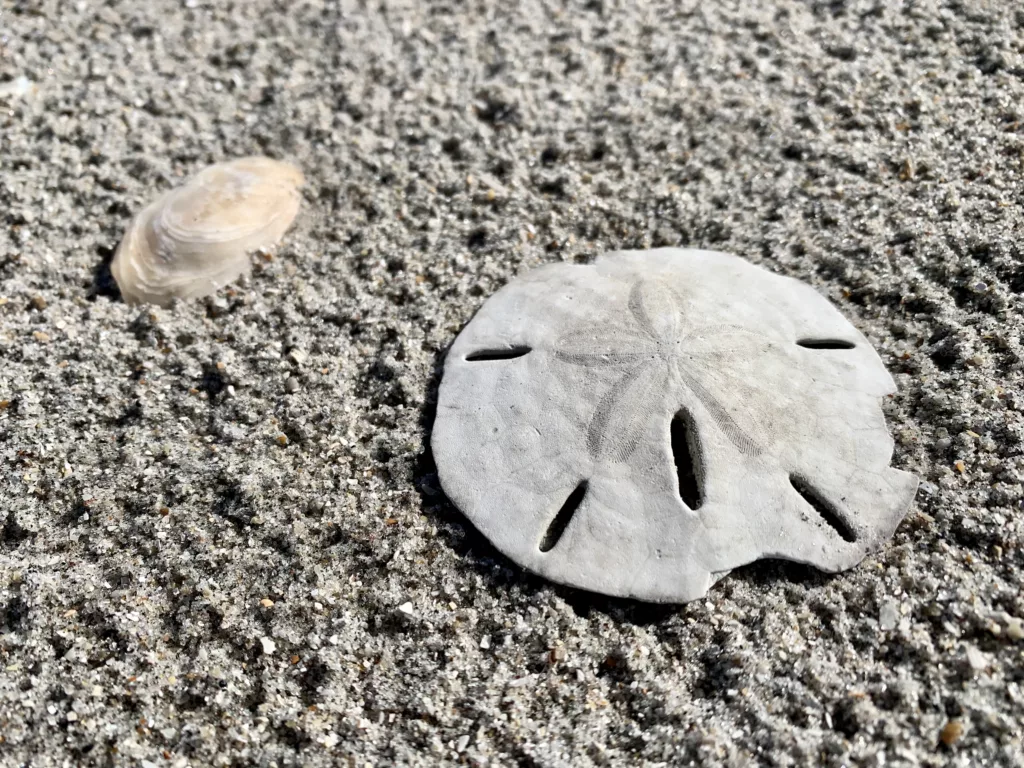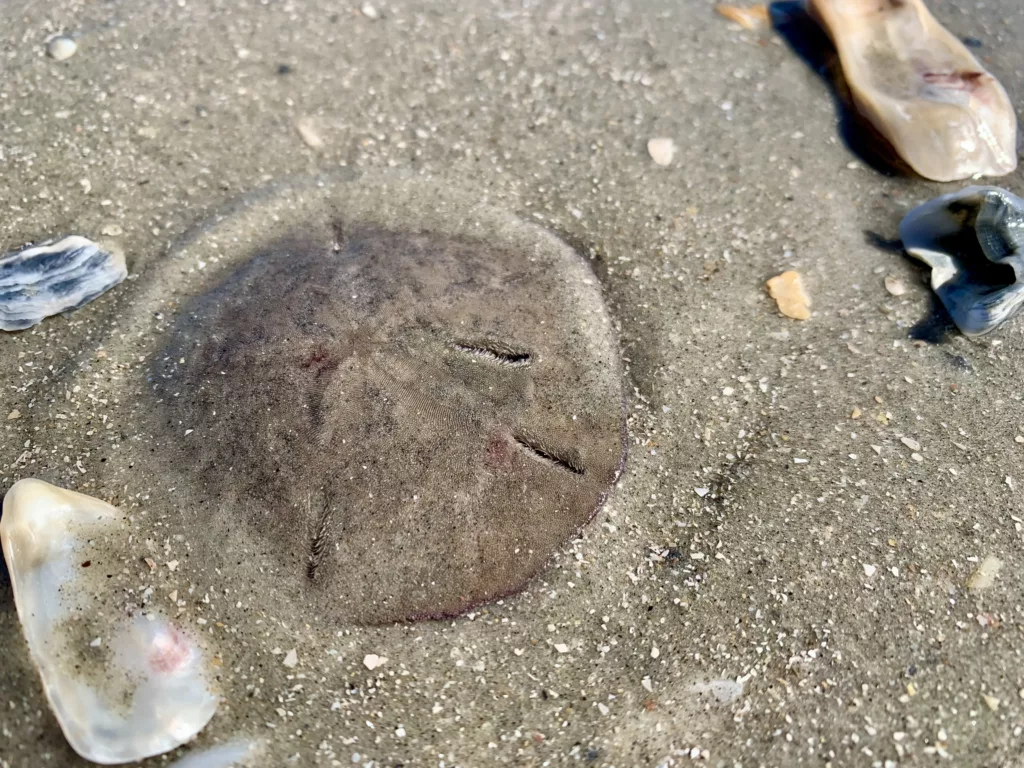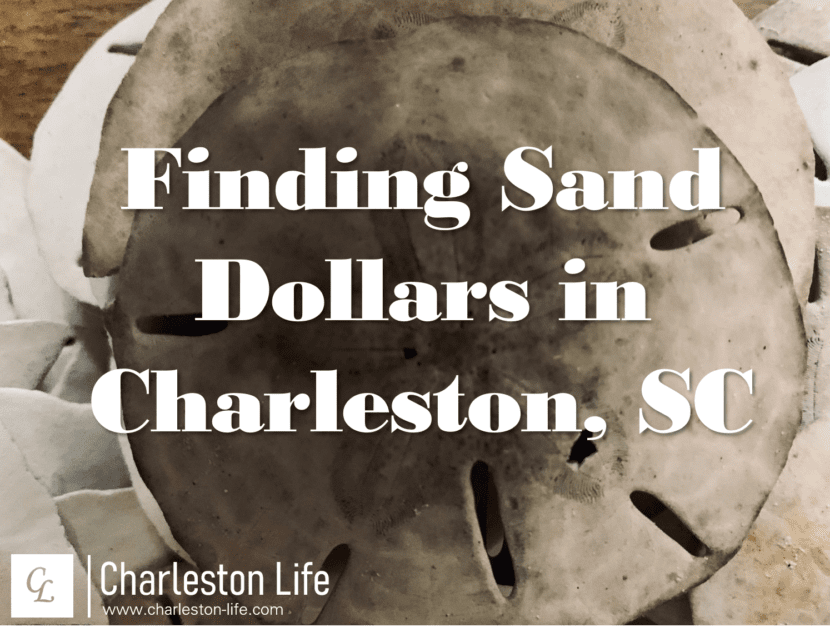No matter how many times you go to the beach, it is always exciting to find a bright white sand dollar laying in the sand. A sand dollar is a great (and free) souvenir to take home with you; and, if you find one that is completely unbroken, you might even decide to put it in a shadow box to hang on your wall. But, part of the reason why sand dollars are so desirable is because they are so rare. So, how do you find sand dollars at Charleston’s beaches?
The simple answer is to look around. If you walk along the shoreline, you never know what you might find. Sand dollars, shells, sea stars, and shark teeth are all there for the picking. But, finding a sand dollar requires knowing where to look, persistence, and a little bit of luck. With this in mind, here is some information you can use to improve your chances of finding a sand dollar at the beach in Charleston:
What Is a Sand Dollar?
You know what a sand dollar looks like, and you know that you want one. But, do you know what a sand dollar is, actually?
A sand dollar is a type of sea urchin. When you find white sand dollar on the beach, what you are actually finding is a sea urchin’s shell, or endoskeleton (also called a “test”), after the urchin has passed away.
As explained by the South Carolina Department of Natural Resources (SCDNR), a sea urchin is a type of echinoderm. Echinoderms are a class of marine invertebrates that has an endoskeleton comprised of a single piece rather than multiple individual bones. Their name comes from the Greek word for “spiny skin;” and, if you’ve ever seen a live sand dollar, you’ll know why. Live sand dollars are covered in tiny spines that are a unique greyish-purple color, and they use these spines to carry food to their mouth, which is located in the middle on the sand dollar’s bottom side.
Sand dollars are a specific type of echinoderm called an echinoid. Other sea urchins that you’ll occasionally find on Charleston’s beaches fall into this category as well. All echinoids have what is known as “radial symmetry,” which is what gives sand dollars their instantly recognizable five-pointed star design.
The sand dollar’s endoskeleton is made of calcium carbonate, which is also found in seashells, eggshells, pearls and a whole host of other biological specimens. Sand dollars are brittle. So, if you find one, be sure to treat it with care.
Here are some more interesting facts about sand dollars:
- Sand dollars can live for six to 10 years. So, while a bleached sand dollar you find on the beach isn’t a fossil, it is still older than you might think.
- While it is pretty rare to find a sand dollar on the beach, sand dollars live on the ocean floor in colonies. Hundreds can live together in just a few square feet.
- Sand dollars spend much of their lives standing on end, using their spines to grab tiny things to eat as they float by. But, they will also burrow under the sand completely, and you might feel one (or several) under your feet in the water at Charleston’s beaches.

Which Charleston Beaches Have Sand Dollars?
You can find sand dollars at all of Charleston’s beaches. We’ve found them from Bull Island all the way down to Edisto Beach—and even on one recent trip to Hilton Head. Of course, when the main beaches around Charleston get crowded during the summer months, you’ll have to get up early—and still get pretty lucky—to find a white sand dollar washed up on the shore. With that said, it is possible to find sand dollars at:
- Bull Island
- Capers Island
- Isle of Palms
- Sullivan’s Island
- Morris Island
- Folly Beach
- Kiawah Island
- Seabrook Island
- Edisto Beach
- Hunting Island
- Hilton Head Island
To have your best chance, though, you’ll want to visit one of the Charleston area’s uninhabited islands that are only accessible by boat or kayak. If you are on vacation (or if you are a local), you can take a guided tour to Bull Island, Capers Island, or Morris Island with Coastal Expeditions. If you have your own boat or kayak, or if you rent a kayak on your vacation, you can head toward one of these islands on your own. Just keep in mind, however, that boating or kayaking in Charleston’s coastal waters requires navigation skills and local knowledge, so you’ll only want to do this if you’re confident in your ability to get there and back safely.
Which is the Best Beach to Find Sand Dollars?
Due to the fact that almost anyone will pick up a sand dollar they find on the beach, the best beaches for finding sand dollars are those that see the least human traffic. From the list above, Bull Island and Capers Island are your best options. If you’re not interested in (or not comfortable with) taking a boat or kayak, then you might head down to Edisto Island and take a walk toward the north end of the beach in Edisto Beach State Park. This is one of the areas that is accessible by land that gets the least visitors, so your chances of finding a sand dollar here are probably better than they are in most other locations.
Folly Beach County Park is another good option as well, and so is Sullivan’s Island. While both of these are pretty close to downtown Charleston, they also get less visitors than the main area of Folly Beach and neighboring Isle of Palms.
If you’re comfortable boating or kayaking near the coast, you have some additional options—and these are likely to be the best options on the list. For example, Otter Island south of Edisto Beach is extremely remote (though there is a shelling tour that goes here from The Marina at Edisto Beach), and Sandy Point Beach (located across Bulls Bay from Bull Island) rarely receives visitors. Just be mindful that a permit is required to take anything from some of these locations (including Otter Island, among others).
Where Are You Most Likely to Find a Sand Dollar?
Most people hoping to find a sand dollar at Charleston’s beaches look along the tide line. While you’ll occasionally find a sand dollar here, if you do, there is a decent chance that it will still be alive (see below for what you need to know about finding a live sand dollar in South Carolina).
Instead of looking by the water, you are most likely to find a sand dollar (or, at least, a sand dollar you can take home) farther up the beach. The best places to look are areas with lots of shells that have been bleached by the sun. Any sand dollars you find here will almost certainly be dry and free for you to take home.
How Do You Find a Sand Dollar?
So, that covers where you can find a sand dollar at the beach in Charleston. Now, how do you find a sand dollar that you can take home with you? Here are five tips for finding a sand dollar at the beach in Charleston:
- Look for Large Shell Deposits – The best place to find a sand dollar is a large shell deposit away from the water’s edge. It shouldn’t be so high on the beach that the water never gets there (if it is, it will most likely be picked over already), but it should be high enough that any sand dollars you find will have had time to dry. The ocean tends to sort shells and other items by size. So, if you find an area with shells that are about three to five inches in size, this will be a good place to look for sand dollars as well.
- Scan for White Circles – When you are looking for sand dollars, scan the ground for white circles. This will occasionally bring you to stop at large cockles that have landed upside down, but it will also help you find any sand dollars that may be there for the picking. Ignore other common shell shapes with angles and swirls, and just try to focus on picking out any circles you see amongst everything else on the ground.
- Don’t Worry about Digging – While some people think they can get lucky and beat the throngs of other searchers by digging through piles of shells or sand, this isn’t the best way to find a sand dollar. You aren’t likely to find a sand dollar by digging; and, if you happen to get extremely lucky and find one, there is a good chance that it will be broken.
- Cover a Broad Area – When searching for sand dollars, you want to cover a broad area. They are rare to find, so you’ll need to cover as much ground as possible.
- Take Your Time – Finally, if you want to find a sand dollar on the beach, you’ll need to take your time. While you want to cover a broad area, you also need to make sure you cover your search area thoroughly. While it might seem like it would be hard to miss a sand dollar, it isn’t—especially in shelly areas. So, go slow, scan the ground systematically, and this will give you the best chance of finding a sand dollar to take home.
Is It Legal to Take Sand Dollars from Charleston’s Beaches?
It is completely legal to take home a sand dollar you find at the beach in Charleston—as long as it is no longer alive. Under South Carolina law, it is illegal to take a live sand dollar (or any other live animal) from the beach. We provide some tips for determining if a sand dollar is still alive below; but, if you are even a little bit unsure, it is best to put any sand dollars that may still be alive back in the water.
But, hopefully you’ll find a bright white sand dollar that you can pick up and carry back with you to your car, vacation home, or hotel room. As we mentioned above, sand dollars are brittle, so don’t put your find in your pocket or in a bag with other items.
How Can You Tell if a Sand Dollar is Still Alive?
There are a few ways you can tell if a sand dollar is still alive. As we mentioned above, taking a live sand dollar from the beach in Charleston is illegal—and it also just isn’t nice for the sand dollar. A sand dollar is still alive if:
- It is greyish-purple in color. Sand dollars’ spines are greyish-purple in color; and, if you find a sand dollar that still has its spines, it is most likely still alive.
- You see its spines moving. Even if a sand dollar’s color has started to fade, if you see its spines moving, it is still alive. Look closely, and give your eyes a few seconds to adjust. The movements will be tiny, but you’ll start to see them after a few seconds.
- Your hand turns yellow after holding it. Living sand dollars produce a substance called echinochrome that, while completely harmless, will turn your skin yellow after about a minute. While it doesn’t necessarily mean a sand dollar is dead if your skin doesn’t turn yellow, if it does turn yellow, the sand dollar is still alive.
Again, if you are not completely sure that a sand dollar is dead (if it is not completely white, smooth, and slightly chalky in texture), then you should put it back in the water. Live sand dollars are completely safe to touch, so you can carry it out a few feet and gently place it in the water or on the sand.

What Else Can You Find on Charleston’s Beaches?
Along with sand dollars, there are many other interesting things you can find (and take home) at the beach as well. For example, many beachgoers find shark teeth at Charleston’s beaches. You can also find many different types of shells, and you may even find a sea star (though these may still be alive as well). Of course, you might find some trash, too, and if you do you can do your part by picking it up and putting it where it goes.
Did you like this article? Subscribe to get notified of new articles via email.
